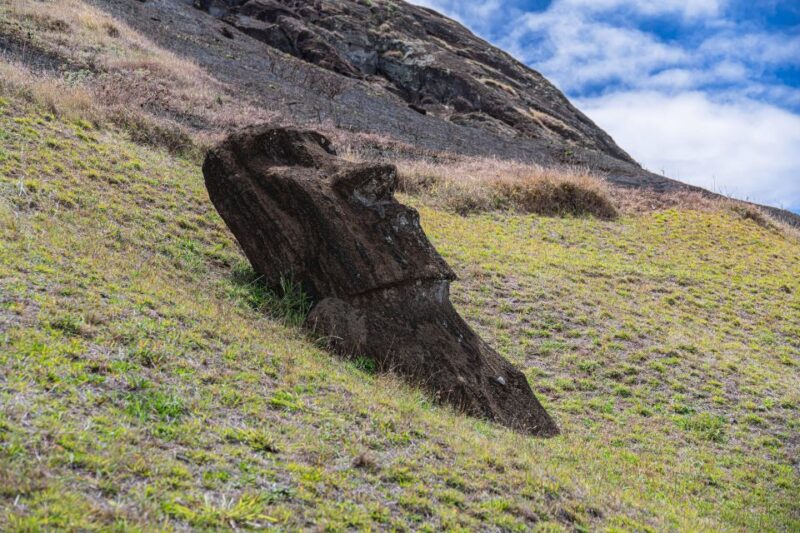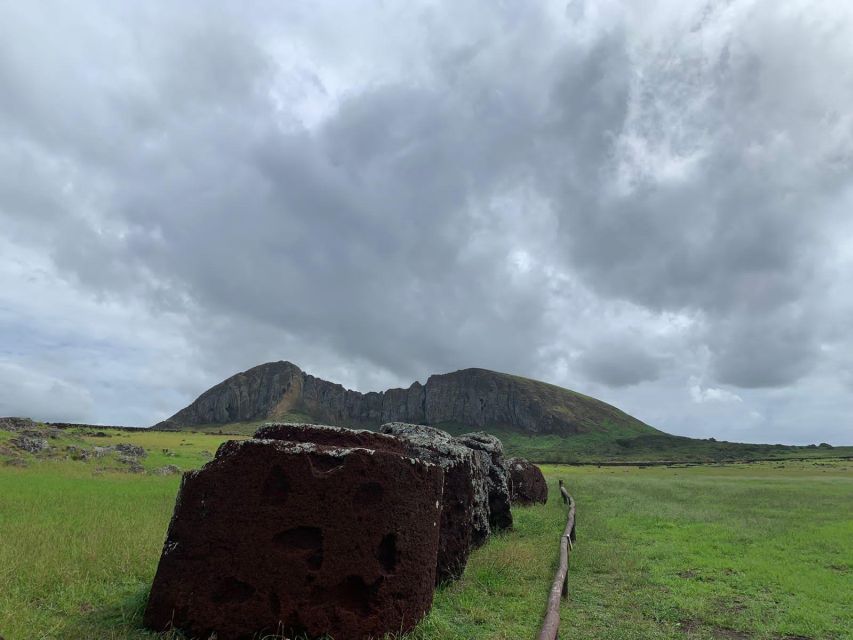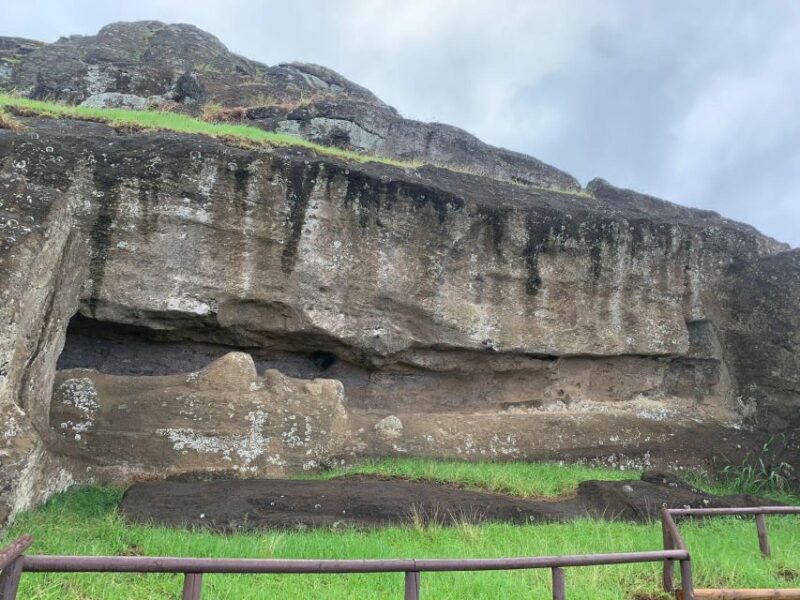Uncover the profound history behind Easter Island’s iconic moai statues on a captivating private tour. Over seven hours, explore the rich cultural heritage of the Rapa Nui people as you explore significant sites like the volcanic quarry where these monumental figures were crafted. From the largest collection of standing moai at Tongariki to the serene Anakena Beach, this in-depth journey promises to unveil the intriguing origins and enduring mysteries surrounding the island’s most famous landmarks. Prepare to be captivated by the untold stories that lie within these striking stone guardians.
Key Points

Key Points:
-
Explore the ancient quarry of Rano Raraku where the iconic moai statues were carved and gain insights into the engineering and cultural artistry of the Rapa Nui people.
-
Witness the largest collection of standing moai at Tongariki, where 15 colossal statues face the rising sun, offering a glimpse into the island’s rich cultural heritage.
-
Discover the remnants of ancient Rapa Nui settlements at Akahanga, including toppled moai and crumbling stone platforms, providing historical insights into the resilience of the island’s inhabitants.
-
Enjoy the serene environment of Anakena Beach, the landing site of the first Polynesian settlers, and reflect on the cultural significance of the moai and the Rapa Nui people’s connection to the island.
-
Visit Vaihu, where dozens of ancient moai statues are scattered across the landscape, allowing you to explore the scale and intricate details of these spiritual representations of deified ancestors.
Tour Overview
This private tour of Easter Island’s historical sites offers participants an immersive exploration of the island’s iconic moai statues and ancient settlements.
The 7-hour tour is limited to just 4 participants, allowing for a personalized experience. Available in English and Spanish, the tour includes transportation, park admission, and a knowledgeable local guide.
Priced from $150 per person, the tour provides free cancellation up to 24 hours in advance and a reserve now, pay later option.
With a perfect 5/5 rating from previous travelers, this tour promises to deliver unforgettable experiences at sites like Tongariki, Rano Raraku, and the picturesque Anakena Beach.
You can also read our reviews of more tours and experiences in Ahu Tongariki.
Itinerary Highlights

The tour explores ancient moai statues scattered across the expansive Vaihu landscape.
At Akahanga, visitors discover remnants of ancient settlements and toppled moai.
The highlight is the volcanic quarry of Rano Raraku, the birthplace of the moai, showcasing statues in various creation stages.
Tongariki boasts the largest collection of standing moai, arranged to face the sunrise.
At Te Pito Kura, the group views the enormous moai and the unique spherical stone with special significance.
The tour concludes with a relaxing stop at Anakena Beach, where travelers can swim in the crystal-clear waters and reflect on Easter Island’s profound cultural heritage.
Vaihu: Moai Statues

Dozens of ancient moai statues lie scattered across the vast Vaihu landscape, their silent presence a testament to the ingenuity and craftsmanship of the Rapa Nui people.
These iconic figures, carved from volcanic rock, are believed to represent deified ancestors and hold deep spiritual significance.
Visitors can explore the site, marveling at the sheer scale and intricate details of the moai, some of which have been toppled by natural forces or human activity over the centuries.
This serene and thought-provoking location offers a glimpse into the rich cultural heritage of Easter Island, setting the stage for the wonders that await on the tour.
Akahanga: Ancient Settlements
Nestled along the rugged coastline of Easter Island, Akahanga reveals the remnants of ancient Rapa Nui settlements.
Wander through the site, where toppled moai statues and crumbling stone platforms bear witness to the island’s rich history.
Explore the foundations of former dwellings and ceremonial structures, offering insights into the daily lives and religious practices of the island’s inhabitants centuries ago.
As you traverse this archaeological gem, you’ll gain a deeper appreciation for the resilience and ingenuity of the Rapa Nui people who once thrived in this remote and isolated landscape.
More Great Thing To Do NearbyRano Raraku: Volcanic Quarry
Visiting Rano Raraku, the volcanic quarry that served as the birthplace of the iconic moai statues, offers a captivating glimpse into the ingenious engineering and cultural artistry of the Rapa Nui people.
This dramatic landscape showcases moai in various stages of completion, providing insight into the carving process and the sheer scale of the undertaking.
Abandoned tools and unfinished statues litter the quarry, evoking the immense skill and dedication required to create these monumental works.
Exploring Rano Raraku, visitors can ponder the reasons behind the creation of the moai and the challenges faced by the Rapa Nui in transporting and erecting these colossal figures across the island.
Tongariki: Largest Moai
At the eastern end of Easter Island, the Tongariki site boasts the largest collection of standing moai, with 15 colossal statues dramatically arranged to face the rising sun.
These majestic figures, some standing over 30 feet tall, were restored in the 1990s after a tsunami devastated the site in 1960.
Visitors are awestruck by the scale and grandeur of the imposing statues, which were carved from volcanic rock and transported from the nearby Rano Raraku quarry.
This iconic location offers a powerful glimpse into the island’s rich cultural heritage and the ingenuity of its ancient inhabitants.
Te Pito Kura: Significant Stone
Situated near the island’s northern coast, Te Pito Kura draws visitors with its enormous moai and a unique spherical stone of special significance.
The moai here is one of the island’s largest, measuring over 30 feet tall.
But the real highlight is the massive, perfectly spherical stone nearby, which is believed to be a source of the island’s mysterious energy.
Researchers are still puzzled by its origins and purpose, though some theories suggest it may have been used for sacred rituals or navigation.
Exploring this enigmatic site offers a chance to delve deeper into Easter Island’s captivating history and the enduring legacy of the moai.
Anakena Beach: Relaxation
Anakena Beach, a picturesque stretch of white sand along Easter Island’s northern coast, offers visitors a chance to unwind and reflect on the island’s captivating history.
Here, travelers can swim in the crystal-clear waters and enjoy the tranquility of the surrounding landscape.
The beach holds cultural significance, as it’s believed to be the landing site of the first Polynesian settlers who established their communities on the remote island.
Visitors can embrace the serenity of this sacred space, contemplating the impressive moai statues and the remarkable resilience of the Rapa Nui people who once called this island home.
Frequently Asked Questions
How Are the Moai Statues Transported to Their Current Locations?
The moai statues were transported using wooden and stone sledges to their current locations on Easter Island. This labor-intensive process involved the coordinated efforts of the island’s inhabitants over many generations.
What Are the Restrictions on Touching or Interacting With the Moai?
Visitors are not allowed to touch or climb on the moai statues. This is strictly prohibited to preserve the cultural heritage and protect the fragile archaeological sites. Guided tours provide information about the moai while respecting these important restrictions.
Are There Any Special Requirements for Visiting the Indigenous Communities?
There are no special requirements for visiting the indigenous communities on Easter Island. Visitors should be respectful and follow any guidelines provided by the local people to ensure a positive cultural exchange.
Is There an Option to Extend the Tour to See More of the Island?
There’s no mention of an option to extend the tour. However, the tour already covers several key historical sites on Easter Island, providing a well-rounded experience within the 7-hour duration. Travelers can inquire about customizing the tour if they’d like to see more.
What Are the Local Customs or Etiquette I Should Be Aware of During the Tour?
Visitors should be respectful of local customs during the tour, such as not climbing on the moai statues. It’s also important to follow the guide’s instructions and avoid disrupting religious or ceremonial sites. Staying mindful of island etiquette will enhance the cultural experience.
The Sum Up
This captivating private tour offers visitors an immersive exploration of Easter Island’s rich cultural heritage. From the iconic moai statues in Rano Raraku to the ancient settlements of Akahanga, the tour provides a comprehensive understanding of the Rapa Nui people’s profound history. Travelers will also discover significant sites like Tongariki and the serene Anakena Beach, making this an unforgettable experience.
You can check if your dates are available here: